Pricing of a product or service plays a significant role in establishing a relationship between a service provider and a client. If a client sees value, the price makes sense, and the translation industry doesn’t deviate from this general rule. However, varying costs can leave potential clients reasonably confused. The reason is straightforward – there are multiple pricing models that can be employed and just as many translation pricing factors that affect them.
To help you wade through this plethora of information, we bring to you, the translation pricing masterclass! Step into our classroom as we take you through our all-encompassing infographic and teach you everything there is to learn about pricing. We promise you; this is a guide like no other!
Machine Vs. Human Translation
The first and most important lesson you will learn is that all translations are not created equal. The good news is that you do have some control over how well your content is translated. The very first decision you will make as a customer is to choose between machine translation & human translation.
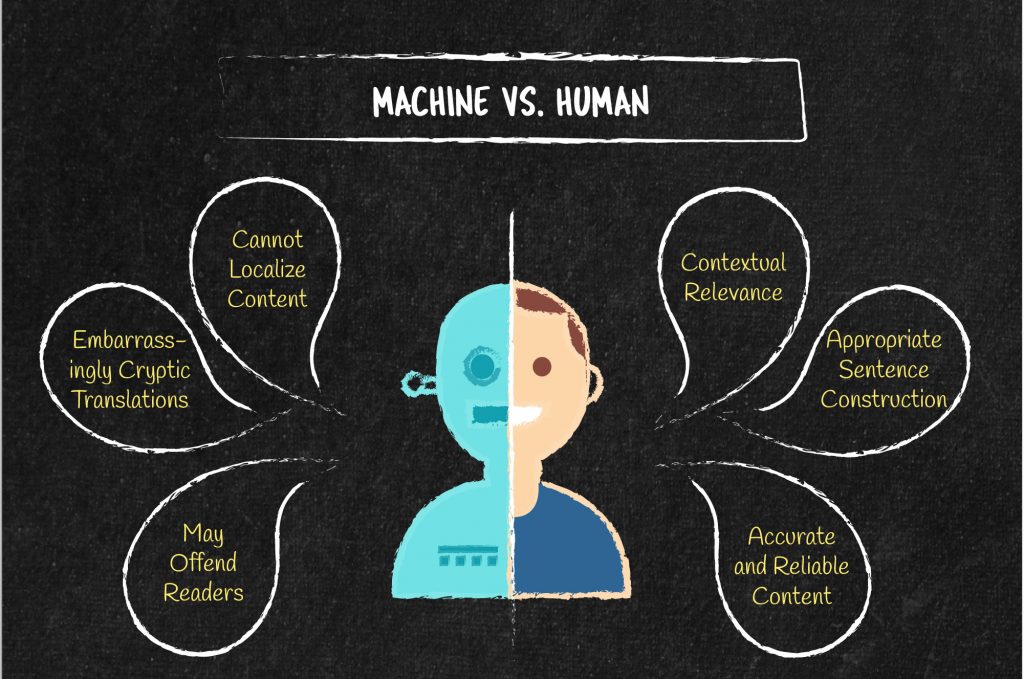
Although machines can translate at a fraction of the cost (or sometimes even for free) the likelihood of incorrect, contextually irrelevant translation is very high, and it is not something you can verify without knowing both the source and target languages. Translation errors have their consequences, and they’re not very pleasant. Human translation, on the other hand, is a much safer approach. Not only can you be sure of accuracy, but your content is also localised for your target audience – something machines falter at every time.
Lesson Tip: Weigh your options carefully. Sometimes it may be acceptable to use machine translation for an immediate personal understanding of some content. However, we strongly recommend you have it professionally translated by a human before taking any further action.
Freelancers or LSPs?
Imagine it is 7 pm on a Saturday, and you’ve just arrived at a nice restaurant to celebrate something special. You’re shown to your table where your waiter welcomes you. Minutes later, you’re introduced to the chef. You order the first course and wait for the waiter for the next course. However, different chefs turn up for each course, none of which know what you’ve previously ordered. Each time, you explain your preferences and food allergies. By the time the food arrives, you’ve spent a large part of the evening giving out similar instructions to a host of people. Your wine doesn’t complement your entrée, and by the time you order dessert, you forget to mention your peanut allergy.
Now coming back to the topic at hand, translation management is a very similar process. When you work directly with freelance translators, you end up coordinating with multiple people for multiple projects! This is a tedious, time-consuming process with a lot of room for error.
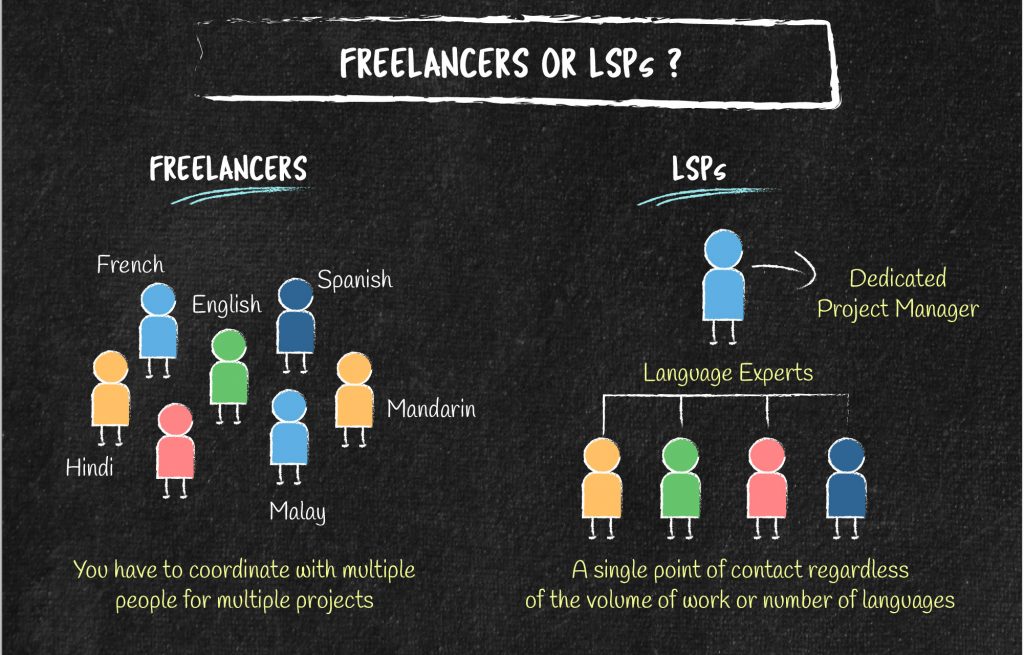
Instead, when you use the services of an LSP, you benefit from a single point of contact regardless of the volume of work or the number of languages. This ensures optimal communication as you know exactly who to reach out to for assistance.
Types of Pricing Models
There are several models used in the translation industry which determine how costs will be calculated. Later, we will also explain the factors that help LSPs arrive at these costs. We hope you’re taking notes!
Per-Word
Per-word pricing is one of the most used pricing models when a definite word count can be found for a given document. This is because it’s simple to calculate, and can be proportionally increased or decreased based on different factors such as volume, urgency, subject area, etc.
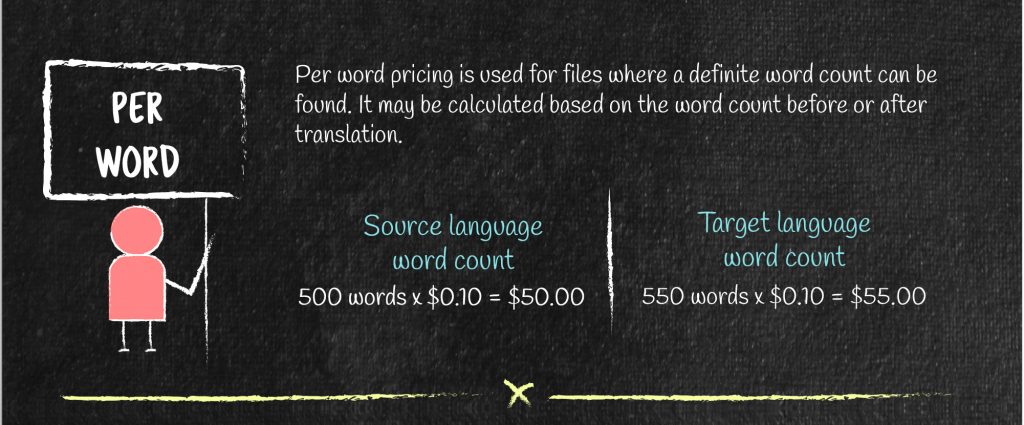
The per-word cost of a project is calculated on the word count either before or after translation. For example, if you need 500 words translated from English to German at a rate of $0.10/word, you would be charged a total of $50.00 if you’re being charged based on the source language word count. However, if the word count increases post-translation by 10% and you are being charged based on the target language word count, you will end up paying $55 instead.
Lesson Tip: Although it is not common practice to be charged based on the target word count, it is always good to ask your project manager how the word count will be calculated and what other factors will determine the per word cost.
Per Page
We once received a unique translation order for some personal letters written in beautiful handwriting. To calculate pricing, our options were to either manually count every word in the notes or to charge per page based on the average word count of a few pages.
Sometimes, a word count is difficult to obtain (electronically). In such cases, it makes a lot more sense for an LSP to charge per page rather than spend hours getting a word count and thereby adding to project management costs. This method is used mainly for image files or handwritten documents.
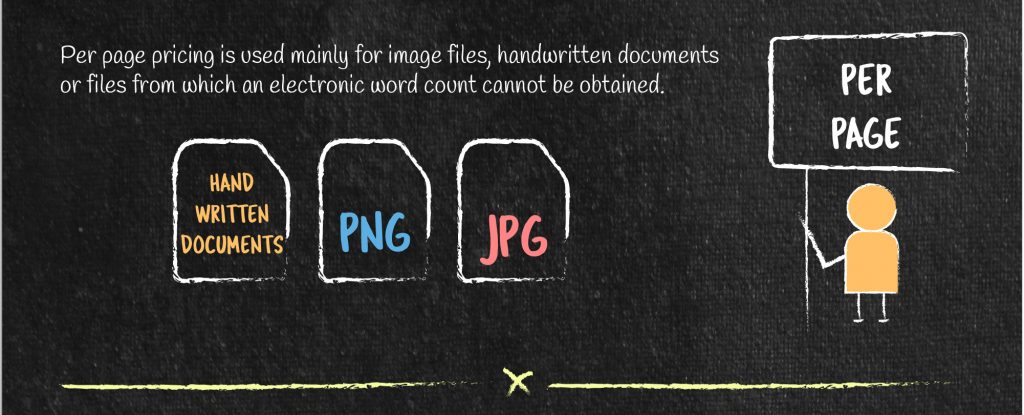
Per Hour
Think of a website that has been recently translated with a few strings of content that need to be updated every week. Although the actual text may be very little, the time taken to manage the work comes with a price. Often, in this case, an LSP may charge the client per hour for the time they spend working on a particular project.
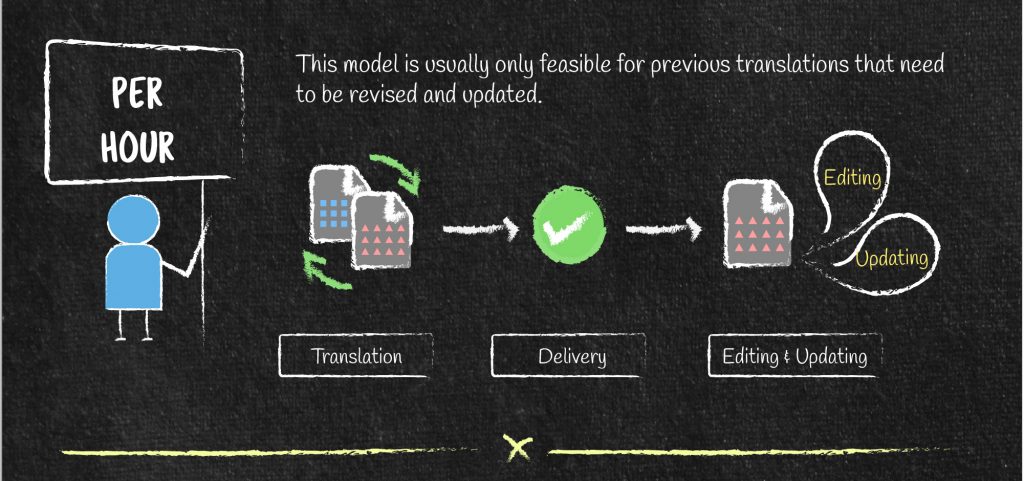
This model is relatively rare as it’s usually only feasible for cases wherein previous translations need to be revised and updated or if managing the translations is a time-consuming process.
Flat Fee
We’ve rarely seen value for customers in the flat fee pricing model. It’s not the most preferred or recommended pricing model for a potential customer as there exists quite a bit of ambiguity in terms of what you’re paying for and how the cost was arrived at. That being said, each pricing model has its place and it’s essential to keep communication clear and open. This model is generally used as a last resort if no other models make sense or the project is very complex, and there are multiple pricing factors at play.
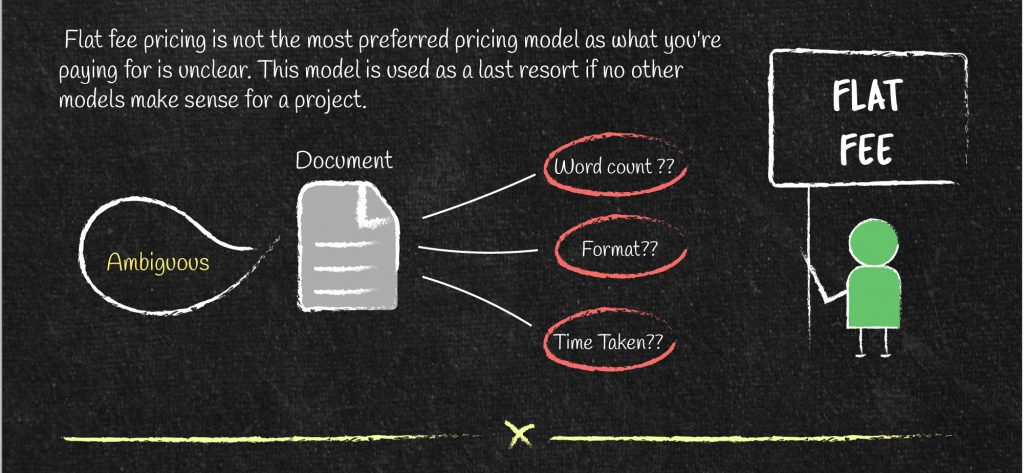
Lesson Tip: If you do find yourself in a situation that required you to pay a flat fee, don’t panic! Remember, when it comes to working with a top LSP, project managers are your best friends. Ask them how the costs were calculated, and they will be only too glad to explain.
Minimum Fee
LSPs regularly receive orders comprising of just a few words. Think of an order for 10 words being charged at $0.10/word. The total cost of the project is $1.00. Once the LSP receives the order, several processes begin. The project manager takes a word count and sends a quote to the client. Once the client confirms, the project is assigned to the right language expert and so on.
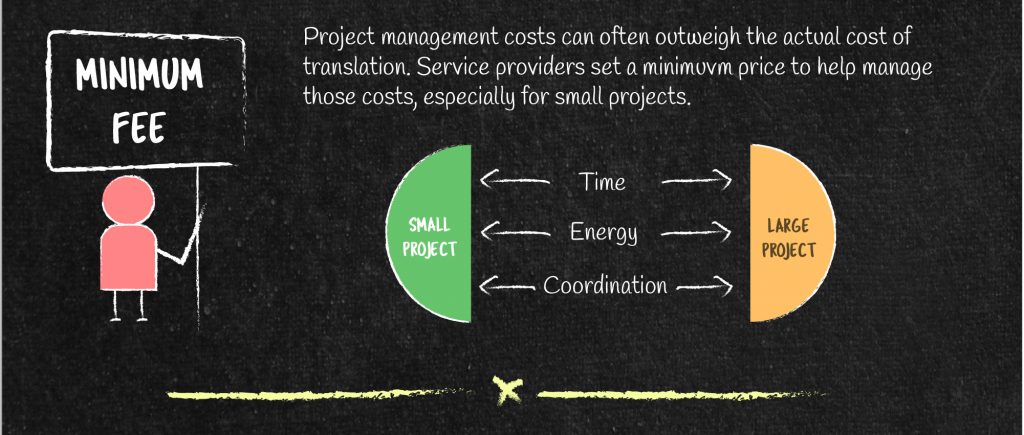
With smaller projects, management costs can often outweigh the actual cost of translation. Good service providers exert the same amount of effort for small projects as they would for larger ones. However, to continue operating optimally, LSPs need to set a minimum price to manage those overheads.
Factors that Affect Pricing
Now that we’ve got a thorough understanding of pricing models, it’s important to take a closer look at how the price is actually determined and which factors have a role to play.
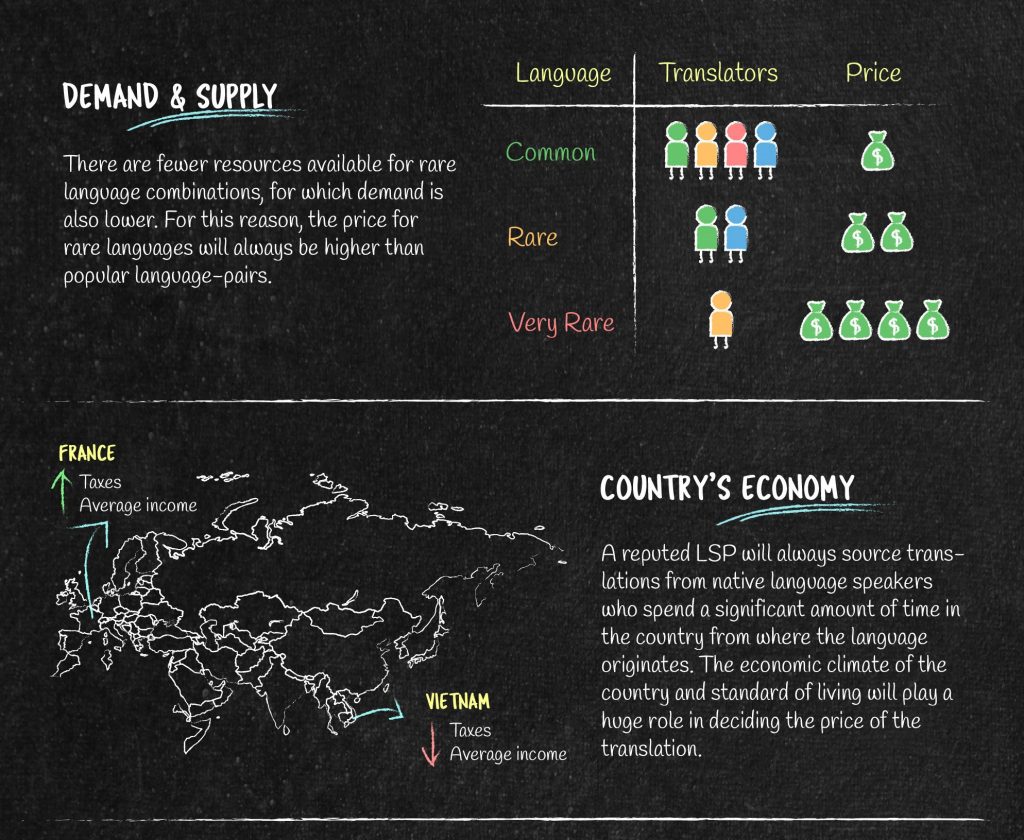
Demand and Supply
The demand and supply of translators is a crucial factor that affects price. There are fewer experts available for rare language combinations. For this reason, the price for rare languages will always be higher than popular language pairs. For example, Spanish is one of the most commonly spoken languages in the world, finding one or even multiple language experts for a language pair that includes Spanish would be relatively easy as compared to finding someone for a tribal language that is spoken only by a handful of people in the world.
Country’s Economy
A reputed LSP will always source translations from native language speakers who spend a significant amount of time in the country from where the language originates. The economic climate, tax regulations of the country, and standard of living will play a massive role in deciding the price of the translation.
It’s important to remember that although the project cost may seem more expensive at face value, the quality of the translation will be much higher than that of a non-native translator.
Urgency
An LSP can process a certain number of words per working day. Urgent orders are charged at a premium rate because to ensure expedited delivery, everyone working on the order does what it takes by going beyond their regular responsibilities and working hours. A well-reputed LSP does not delay other projects to fulfil someone else’s. Instead, they employ more resources or work extra to ensure all clients are satisfied.
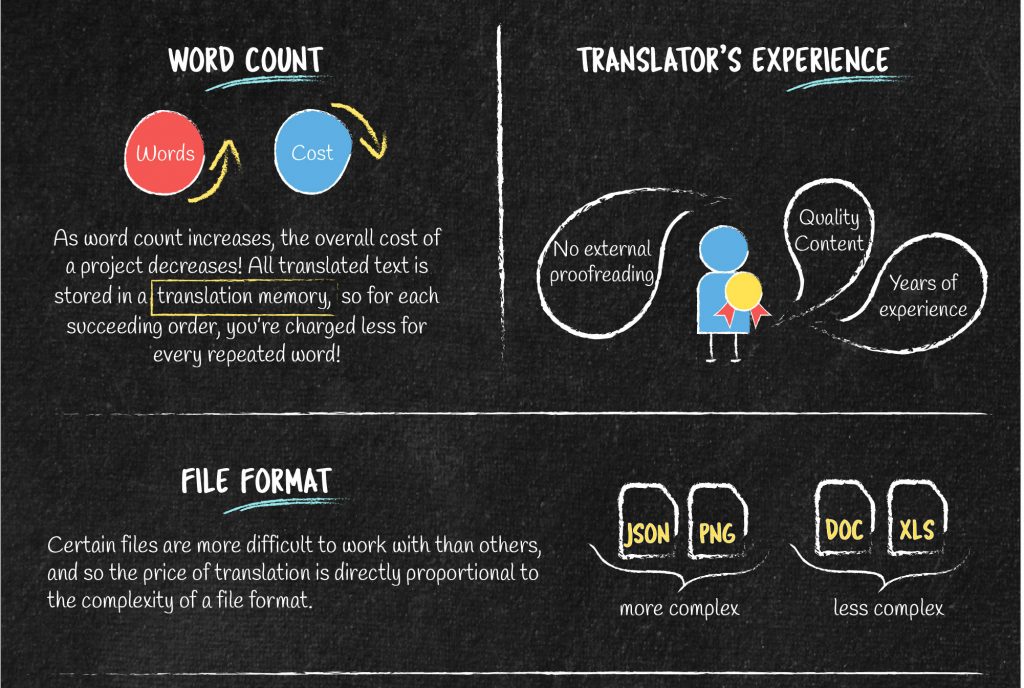
Word Count
Contrary to popular belief, translation costs don’t increase in proportion to the word count! As word count increases, the overall cost of a project actually decreases because well-reputed LSPs store all translated text in what is called a translation memory. So for each subsequent order, you’re charged less for every repeated word!
Translator’s Experience
All professionals become better with time, and translators are no different. Seasoned translators know all the tricks of the trade, don’t require external proofreading or multiple quality checks; however, their years of experience often come with a slightly higher price.
File Format
Certain files are more difficult to work with than others. Document translation for a Word file is easy to work with in terms of familiarity and formatting. Most individuals work with Word files regularly. However, when it comes to more complex file types, like JSON or PNGs, the LSP needs to ensure that the language expert has experience working with such formats and the platforms through which they are accessed. This is especially true for projects related to website and app localisation. As a result, the format may influence the cost of your translation.
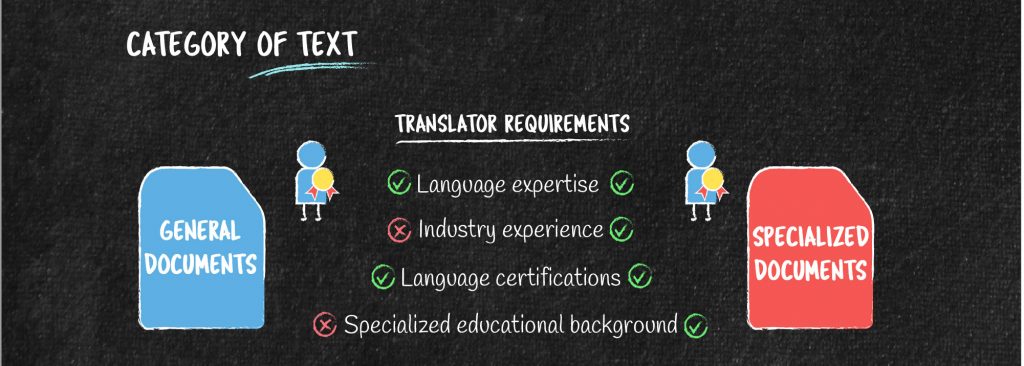
Category of Text
LSPs broadly categorise translation projects into two main groups – general and specialised. General category translations are less expensive than specialised translations because they do not require language experts with additional qualifications. Translators for specialised or industry-specific projects usually need to have an educational background and certifications related to their subject area in addition to their language expertise.
For example, a user manual for a medical device like a sonography machine would require someone with a medical background, with experience in translating such documents.
Ending Notes
Now that you know the different pricing models and factors related to translation pricing, you’re in a much better place to have a healthy discussion with your LSP when starting a project.
As we conclude our pricing masterclass, we hope all your questions have been answered. We know this is quite a bit of information to take in which is why we’ve created a downloadable pricing infographic for easy reference! Remember, each requirement is unique and should be reviewed by a qualified project manager before the commencement of a project. As always, reach out to us for any questions you may have about translation pricing.


